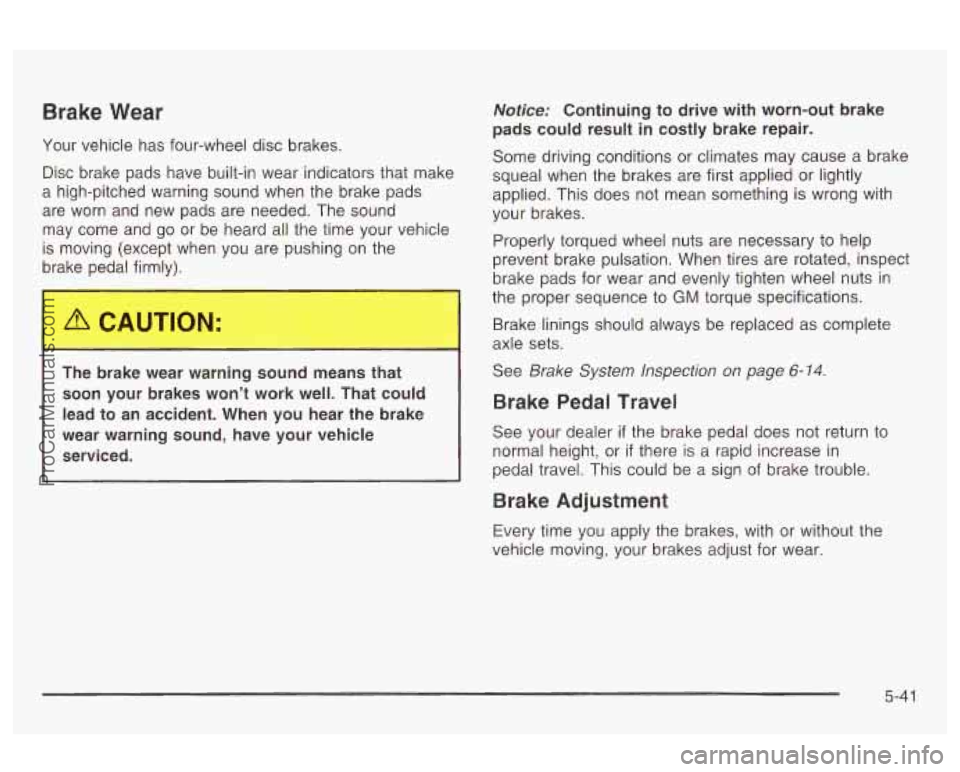Page 86 of 387

Starting and Operating Your
Vehicle
New Vehicle Break-In
Notice: Your vehicle doesn’t need an elaborate
“break-in.” But
it will perform better in the long run
if you follow these guidelines:
e
e
e
Don’t drive at any one speed - fast or
slow
- for the first 500 miles (805 km). Don’t
make full-throttle starts.
Avoid making hard stops for the first
200 miles
(322 km) or so. During this time your new
brake linings aren’t yet broken in. Hard stops
with new linings can mean premature wear and
earlier replacement. Follow
this breaking-in
guideline every time you get new brake linings.
Don’t tnw a trailer during break-in. See “Tawing
a Trailer” in the Index for more information.
Ignition Positions
With the ignition key in the
ignition switch, you can
turn the switch to four different positions.
Notice: If your key seems stuck in OFF and you
can’t turn
it, be sure you are using the correct key;
if
so, is it all the way in? If it is, then turn the
steering wheel left and right while you turn the key
hard. Turn the key only with your hand. Using a
switch. If none of these works, then your vehicle needs service.
iooi io furce ii cuuid Gi-e“-k tiie key UI tijZ. iyr,itior,
OFF: This is the only position in which you can remove
the key. This position locks your ignition and transaxle.
It’s a thzft-de:e;;ent feature.
2-23
ProCarManuals.com
Page 222 of 387

Towing
Towing Your Vehicle
Consult your dealer or a professional towing service
you need to have your disabled vehicle towed. See
Roadside Assistance Program on page 7-5.
Here are some important things to consider before you
do recreational vehicle towing:
if
If you want to tow your vehicle behind another vehicle
for recreational purposes (such as behind
a motorhome),
see “Recreational Vehicle Towing” following.
Recreational Vehicle Towing
Recreational vehicle towing means towing your vehicle
behind another vehicle
- such as behind a motorhome.
The two most common types of recreational vehicle
towing are known as “dinghy towing” (towing your
vehicle with all four wheels on the ground) and “dolly
towing” (towing your vehicle with two wheels on
the ground and two wheels up on
a device known as a
With the proper preparation and equipment, many
vehicles can be towed in these ways. See “Dinghy
Towing” and “Dolly Towing,” following.
“dolly”).
What’s the towing capacity of the towing vehicle?
Be sure you read the tow vehicle manufacturer’s
recommendations.
How far will you tow? Some vehicles have
restrictions on how far and how long they can tow.
Do you have the proper towing equipment?
See your dealer or trailering professional for
additional advice and equipment recommendations.
Is your vehicle ready to be towed? Just as you
would prepare your vehicle for a long trip, you’ll
want to make sure your vehicle is prepared to be
towed. See
Before Leaving on a Long Trip on
page 4-23.
Dinghy Towing
Nofice: Towing your vehicle with all four wheels on
the ground will damage drivetrain components.
\I .-1-:-1- ...-- ...- I -1--:----1 I- I-- I -... ^^ I ... :*I- -11 z -..- I UUI VCIIlLlt: VVd3 llUL UG31YI IGU 1U Ut: LUVVGU VVI11 I all IUUl
wheels on the
ground. If your vehicle must be towed,
you should
use a dolly. See “Dolly Towing” that follows
for more information.
4-33
ProCarManuals.com
Page 274 of 387

Brake Wear
Your vehicle has four-wheel disc brakes.
Disc brake pads have built-in wear indicators that make
a high-pitched warning sound when the brake pads
are worn and new pads are needed. The sound
may come and go or be heard all the time your vehicle
is moving (except when you are pushing on the
brake pedal firmly).
The brake wear warning sound means that
soon your brakes won’t work well. That could
lead to an accident. When you hear the brake
wear warning sound, have your vehicle
serviced.
Notices Continuing to drive with worn-out brake
pads could result in costly brake repair.
Some driving conditions or climates may cause a brake
squeal when the brakes are first applied or lightly
applied. This does not mean something is wrong with
your brakes.
Properly torqued wheel nuts are necessary to help
prevent brake pulsation. When tires are rotated, inspect
brake pads for wear and evenly tighten wheel nuts in
the proper sequence to
GM torque specifications.
Brake linings should always be replaced as complete
axle sets.
See
Brake System Inspection on page 6- 14.
Brake Pedal Travel
See your dealer if the brake pedal does not return to
normal height, or
if there is a rapid increase in
pedal travel. This could be a sign of brake trouble.
Brake Adjustment
Every time you apply the brakes, with or without the
vehicle moving, your brakes adjust for wear.
5-4 1
ProCarManuals.com